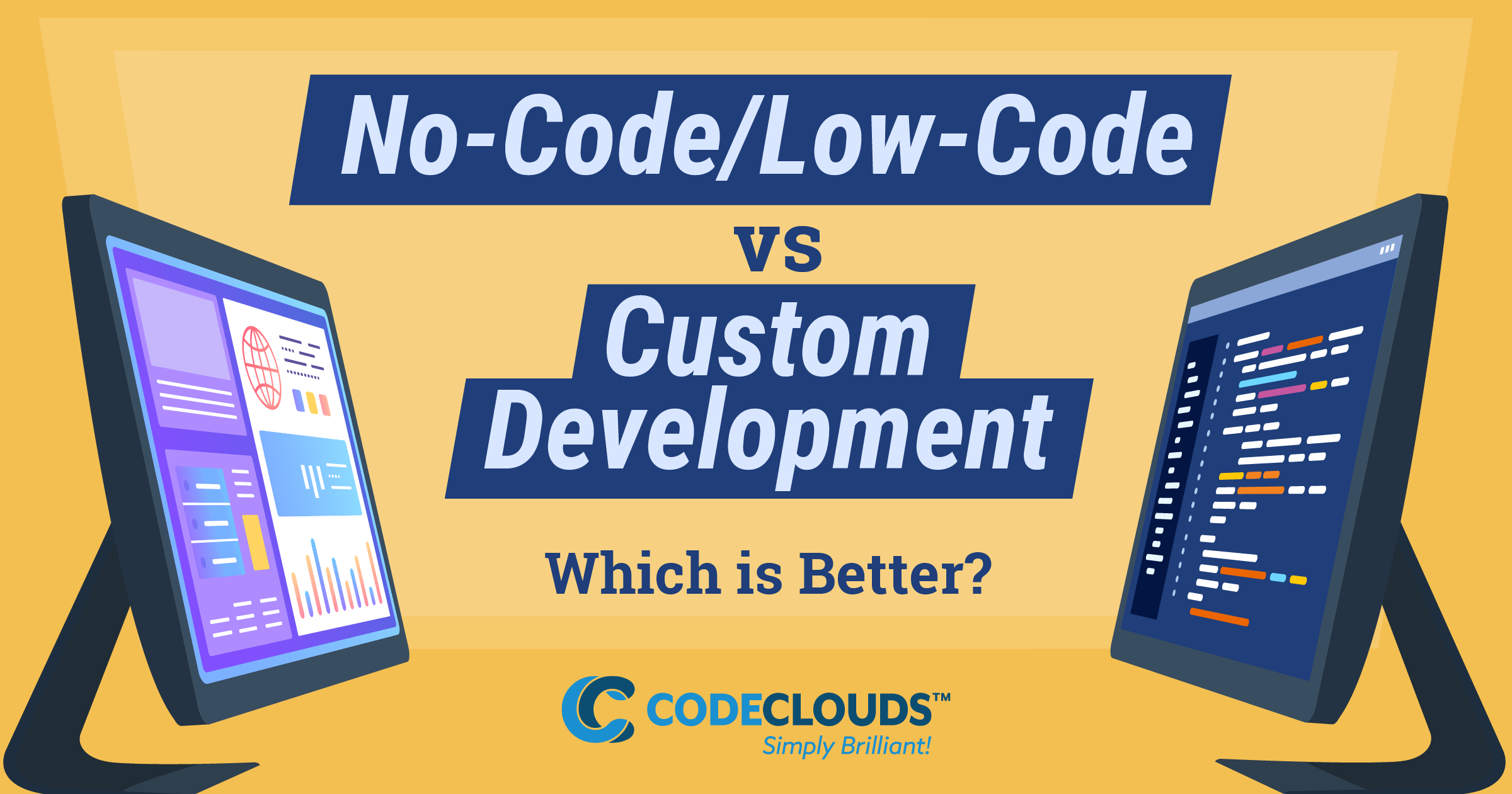Overview
No-code/low-code development and custom development both have their advantages, which can make it hard to choose which development methods to use. Here, we will look at the benefits and drawbacks of each type of development, from cost to customization, and why custom development is the smarter choice for your business.

What Are No-Code And Low-Code Development?
No-code and low-code development are not the same thing, though they do have things in common. What’s the difference?

As you can see, there is an overlap between the two: both methods are time saving and provide limited customization. Many no-code platforms offer low-code options and vice-versa. Both are usually run on an aPaaS (Application Platform as a Service) basis.
For the sake of simplicity, we’ll group no-code and low-code development together in this article, while still highlighting the differences between them.
What Is Custom AKA Traditional Development?
Custom development is creating software from scratch, using skilled developers. Until recently, this was the only option available for software development, which is why it is also known as “traditional development”.
The Benefits of No-code and Low-code
No-code and low-code development have several advantages over custom development, including:
Accessibility
The best thing about no-code development is that anyone can do it, including teams who specialize in the content of the software (e.g. marketing, HR). Obviously, this applies less to low-code development, but it’s a really big deal, especially when considering a shortage of developers and the price of hiring a developer, which can be prohibitive to small companies (though it doesn’t have to be).
Time
If you need to develop a program quickly (and speed is your main priority), then no-code and low-code platforms are the best choice, enabling you to create your software in weeks not months. This is because you don’t have to build your software from scratch: low-code or no-code platforms will get you part of the way there with pre-built blocks of code. This is compared to the average custom development which takes 4-9 months. And less time to code means less…
Cost
Because they’re so quick and either don’t involve hiring a developer or involve less developer involvement, no-code and low-code programs are cheaper. In the case of no-code platforms, you may only be paying for access to the platform. The lower cost means that low-code and no-code platforms can be the ideal choice for start-ups and small businesses who don’t require too much from their software.
This having been said, people often overestimate the cost of custom development.
Maintenance
No code or low-code software platforms are usually maintained by the software company, which means that you don’t have to pay anyone to maintain them. However, with custom development, you do have more control over changes to your platform.
The Benefits of Custom Development
There are many, if not more, benefits of custom development compared to low-code or no-code development:
Customization, Flexibility, and Control
The main benefit of custom development is customization. Customizing no-code or low-code software is difficult and time-consuming, which negates some of the cheapness of these platforms. Low-code and no-code platforms also tend to have issues with integration and speed, as well as restrictions on how much they can be altered.
This lack of flexibility and control contrasts strongly with custom development where you can create anything you want (provided you have the developer skill to do so). This means that custom development is far superior for creating specialized and complicated programs.
Quality
Software created using custom development tends to be higher quality for several reasons. Firstly, it’s designed by expert developers who understand how software works. Then there is the reason mentioned above — that software created via custom development is more fit for purpose as it is built to the exact needs of clients. Finally, custom development produces more original software, which means you can hold the…
Rights
Software that you’ve created through custom development belongs completely to you, allowing you to use it for commercial purposes if you want to. With no-code and low-code development, however, you may not be able to download your software’s source code, limiting what you can do with it.
Security
Choosing custom development ensures your software is as secure as you can make it. The security of no-code and low-code platforms, on the other hand, depends on the service provider, and many low-code or no-code platforms have issues with security. This means that it’s not a good idea to use no-code and low-code platforms for anything that involves sensitive data.
In some cases, you may even encounter issues with privacy and data collection from the platform itself, which is why it’s important to check the TOS (Terms of Service) for low-code and no-code platforms.
While there are many benefits of low-code, no-code, and custom software development, custom development comes out on top for building high-quality software. Custom development’s ability to create individualized solutions that are high quality and secure generally wins out over the cost and speed of no-code and low-code options. However, it’s useful to know the difference between these development methods so that you can make informed decisions for what is best for your business.

Want to look into custom development, but concerned about having to choose between price and quality? Rely on CodeClouds for high-quality, competitively-priced app development.
Share this article
549 reads
Similar Reads








